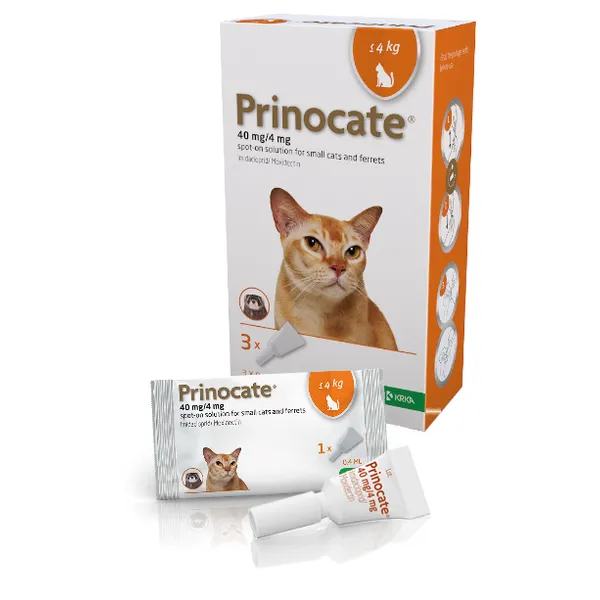For external use only (spot-on use).
Dosage schedule for cats:
The recommended minimum doses are 10 mg/kg bodyweight imidacloprid and 1.0 mg/kg bodyweight moxidectin, equivalent to 0.1 ml/kg bodyweight of the veterinary medicinal product.
The treatment schedule should be based on individual veterinary diagnosis and on the local epidemiological situation.
Administer in accordance with the following table:
| Cats [kg] |
Pipette size to be used |
Volume [ml] |
Imidacloprid [mg/kg b.w.] |
Moxidectin [mg/kg b.w.] |
| ≤4 |
imidacloprid/moxidectin 40 mg/4 mg spot-on solution for small cats and ferrets |
0.4 |
minimum of 10 |
minimum of 1 |
Flea treatment and prevention (Ctenocephalides felis):
One treatment prevents future flea infestation for 4 weeks. Pre-existing pupae in the environment may emerge for 6 weeks or longer after treatment is initiated, depending upon climatic conditions. Therefore, it may be necessary to combine treatment with this veterinary medicinal product with environmental treatments aimed at breaking the flea life cycle in the surroundings. This can result in a more rapid reduction in the household flea population. The veterinary medicinal product should be administered at monthly intervals when used as part of a treatment strategy for flea allergy dermatitis.
Treatment of ear mite infestation (Otodectes cynotis):
A single dose of the veterinary medicinal product should be administered. A further veterinary examination 30 days after treatment is recommended as some animals may require a second treatment. Do not apply directly to the ear canal.
Treatment of notoedric mange (Notoedres cati):
A single dose of the veterinary medicinal product should be administered.
Treatment of the lungworm Eucoleus aerophilus (syn. Capillaria aerophila) (adults):
A single dose of the veterinary medicinal product should be administered.
Prevention of Aelurostrongylus abstrusus:
The veterinary medicinal product should be administered monthly.
Treatment of Aelurostrongylus abstrusus:
The veterinary medicinal product should be administered monthly for three consecutive months.
Treatment of the eye worm Thelazia callipaeda (adults):
A single dose of the veterinary medicinal product should be administered.
Heartworm prevention (Dirofilaria immitis):
Cats in areas endemic for heartworm, or those which have travelled to endemic areas, may be infected with adult heartworms. Therefore prior to treatment with the veterinary medicinal product, the advice provided in section 3.5 of the PIL should be considered.
For prevention of heartworm disease, the veterinary medicinal product must be applied at regular monthly intervals during the time of the year when mosquitoes (the intermediate hosts which carry and transmit heartworm larvae) are present. The veterinary medicinal product may be administered throughout the year or at least 1 month before the first expected exposure to mosquitoes. Treatment should continue at regular monthly intervals until 1 month after the last exposure to mosquitoes. To establish a treatment routine, it is recommended that the same day or date be used each month. When replacing another heartworm preventative veterinary medicinal product in a heartworm prevention programme, the first treatment with this veterinary medicinal product must be given within 1 month of the last dose of the former medication.
In non-endemic areas there should be no risk of cats having heartworm. Therefore they can be treated without special precautions.
Roundworm and hookworm treatment (Toxocara cati and Ancylostoma tubaeforme):
In areas endemic for heartworm, monthly treatment may significantly reduce the risk of re-infection caused by the respective roundworms and hookworms. In areas non-endemic for heartworm, the veterinary medicinal product can be used as part of a seasonal prevention programme against fleas and gastrointestinal nematodes.
Dosage schedule for ferrets:
One pipette of the veterinary medicinal product for use in small cats and ferrets (0.4 ml) should be administered per animal.
Do not exceed the recommended dose.
The treatment schedule should be based on the local epidemiological situation.
Method of administration:
- Remove the pipette from its packaging. Hold the pipette in an upright position, twist and pull the cap off.
- Turn the cap around and place the other end of the cap back on the pipette. Push and twist the cap to break the seal, then remove the cap from the pipette.
- Part the coat on the animal's neck at the base of the skull until the skin is visible. Place the tip of the pipette onto the skin and squeeze the pipette several times to empty its contents completely and directly onto the skin in one spot. Avoid contact between the veterinary medicinal product and your fingers.
Application at the base of the skull will minimise the opportunity for the animal to lick the veterinary medicinal product. The veterinary medicinal product should only be applied to undamaged skin.
Patient Information Leaflet

